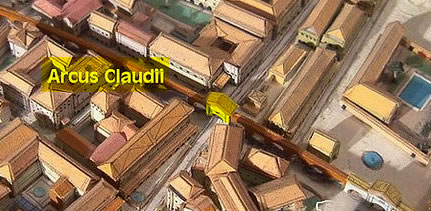Arch of Claudius

When Claudius became emperor decided that for the glory of Rome would have done as much as his father Drusus and expanded the empire's territories ending the conquest of Britain that his nephew Caligula had just started. Claudius left Rome in March of 43 with a strong army of four legions and 20,000 auxiliary and with that crossed the canal landing at Rutupie (Kent coast); the field command was entrusted to Aulus Plautius but the same Claudius led the troops, and after many bloody clashes and it came to the battle of the River Medway, where the victory of the Romans marked the campaign began that ended in 47 with the subjugation of Britain.
Claudius left Britain after just 16 days of Medway victory and the response to its letter by which informed the Senate and Rome. The Senate immediately decreed him the Triumph, an anniversary celebration and the construction of a Triumphal Arch. The construction was started in 44 AD but we do not know if it was already over when it was celebrated the triumph for the victory over Britain. From Suetonius we know that the triumph was celebrated with maximo apparatu but there is no reference on the arch of which speaks instead Dio Cassius. The arc also appears in coins issued between 46 and 48 A.D. and probably it was not completed before those dates.
The Arch was erected along the road that the leader and the victorious legions from North traveling along to go to celebrate the Triumph: the Via Lata. Likely to complete it in a short time it was decided to carry it along the path of the Aqua Virgo aqueduct using a fornix.
It remains very little of arch unfortunately; we know that Claudius wanted the arch was also a Julio-Claudian gens celebration but the statues that adorned were lost and academics have done a patient work of recovery remained fragments of inscriptions and have related them to the descriptions of historians and managed to shed light on the complex relationships between members to Julia gens had among them.
A representation of how it might have been the arch we find it in a Pirro Ligorio drawing . The most important parts were the statues and bas-reliefs that decorated the arch of them arrived to date what is the Praetorian Guard, who had acclaimed Emperor Claudius after the death of Caligula, and is exhibited in the Louvre in Paris.
An important fragment of DEDICATIO, is instead at the Capitoline Museums in Rome; from the fragment was possible to reconstruct the entire text that indicates how many were the king of the Britons defeated Claudius; to be noted that the Channel crossing is described as "trans Oceanum".
The triumphs were real instruments of propaganda and the triumph that the Senate gave to Claudio was celebrated with great emphasis; embassies of congratulation were sent from many cities and governors of the provinces was allowed to come to Rome to participate.
But all return of Claudius from Britain was a long triumphal march witnessed by the finds that have been found, for example, in Verona - where inscriptions testify to the passage of Claudius which probably In the same occasion recognized to the city the honorary title of colonia - and on Golden Gate of Ravenna ...
Sign up and read the rest of the article!
by M.L. ©ALL RIGHTS RESERVED (Ed 1.0 - 17/07/2016)






